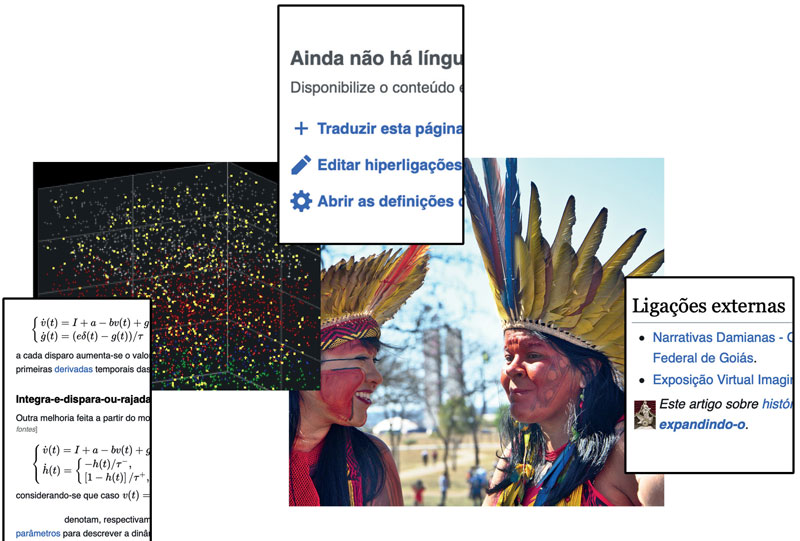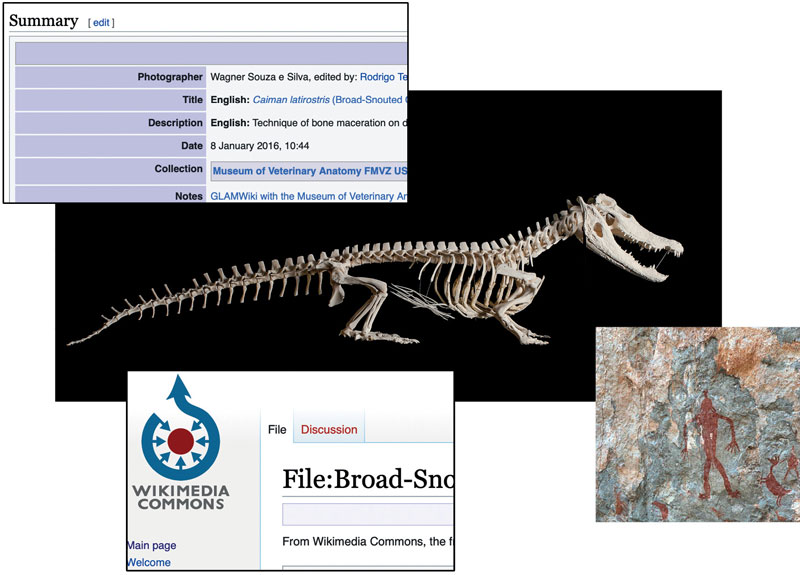If you’ve ever turned to the internet to research Brazilian Indigenous history, chances are you’ve encountered a useful Wikipedia page on the topic, with links to over 38 websites and citations from 20 books. This is just one of thousands of entries on the online encyclopedia that have been created or supplemented by researchers and students from Brazilian universities. As part of scientific initiation or outreach programs, university extension activities, or classroom assignments, students collaborate to create evidence-based entries on the encyclopedia. With an average of 135.4 million visits per month, Wikipedia was the 10th most visited website in Brazil in 2023.
Since 2011, at least 35 Brazilian universities have launched over 239 different educational programs on Wikimedia platforms, including editing entries or creating online forums and courses. These programs have also contributed content to Wikimedia Commons, a repository for images, audio, and videos, as well as to Wikiversity, a free platform for creating study groups and online courses. Wikimedia relies on volunteers with scientific backgrounds to enhance its content. For professors, it’s an opportunity to encourage students to dive deeper into topics they are interested in and share that knowledge with a wide audience. Wikipedia hosts over 61 million articles in 321 languages, including about 1.1 million in Portuguese.
Among the collaborative editing initiatives launched in Brazil is the Indigenous Women on Wikipedia Lab at Fluminense Federal University (UFF), where students and researchers created the previously mentioned entry on Indigenous history. The lab is led by historian Elisa Garcia, an expert in Indigenous studies, who in 2020, during the COVID-19 pandemic, had to shift her work online. She began using Wikipedia to motivate her undergraduate students to edit articles with well-researched information.
Garcia has also used online training programs provided by the platform — such as Wikiconnecta, a free, open course for educators. During the first semester of 2024, Garcia and her students improved an article on a sacred Indigenous garment called the Tupinambá cloak. “The most well-known of these relics is currently in Denmark and is expected to be returned to Brazil this year. We figured people would be looking for information about it and found that the Wikipedia article describing it was only two paragraphs long. It was very much incomplete,” she says. The expanded article now includes sections on how these cloaks are currently made, the repatriation of the Danish cloak, and additional references.
Once published, edits and new articles on Wikipedia are reviewed by its community of volunteer editors. Anyone can create an account and make edits, but there are good-practice guidelines that need to be followed, such as using academic references, addressing widely relevant topics, and avoiding excessive self-references. Occasionally, an article might be challenged. This happened to historian Andressa Inácio, a doctoral researcher at UFF under Garcia’s supervision. Alongside her doctoral research, Inácio is an active member of the Wiki Movimento Brasil project team. In 2020, while studying Indigenous women’s history for her master’s degree, she created an article on the 1st Global Indigenous Women’s Gathering, held virtually that September.
However, the Wikipedia community suggested that the article be removed. In such cases, a discussion is opened where senior members evaluate the article’s significance and the arguments for its removal. “They felt the topic wasn’t notable enough as it was a recent event,” she recalls. “They suggested I include my article as part of a more broad-ranging entry.” In response, Inácio created a new page about Indigenous women’s movements in Brazil, including a section about the event. “Beyond its role in scientific outreach, Wikipedia serves as a valuable laboratory for students to explore various aspects of public history — a field concerned with bringing knowledge about history beyond the walls of academia,” Garcia notes. “On Wikipedia, historians are engaging directly with an audience that evaluates their work, requiring them to provide robust rationale to keep their content live,” she adds.

Ederporto / Wikimedia Commons | Apib Comunicação / Wikimedia CommonsAn image of neural firing patterns (on the left) and a photograph illustrating the Wikipedia entry on Indigenous Women’s Movements in BrazilEderporto / Wikimedia Commons | Apib Comunicação / Wikimedia Commons
An entry created by history students at the Federal University of Mato Grosso (UFMT) also faced scrutiny from the Wikipedia community. The students had developed a page on the Center for Documentation and Regional Historical Information, which manages the Midwestern state’s historical archives. Critics argued for its deletion, claiming it functioned as an advertisement for UFMT, as the students were from the university and the center is hosted there. “Our entry was discussed, and we clarified that the Center is listed in the Brazilian Archive Directory and is not just a university department. Ultimately, the entry was retained,” says Caroline Mendes, a historian at UFMT who manages an extension course aimed at broadening coverage of Mato Grosso’s history and culture on Wikipedia.
“We noticed a lack of information and academic references about the state’s people, places, and popular culture. Most of the Brazil-related content was focused on the country’s South and Southeast.” Approximately 40 students have participated in the extension course, which wraps up in July. They created 22 entries and uploaded 1,600 photos to Wikimedia Commons. Among the new entries created by the project are the history of the Ponte de Pedra Indigenous Reservation and a biography of Dunga Rodrigues (1908–2001), a writer and musician from Cuiabá who authored books on the region’s culture and history.
During a project at UFMT in 2023, Gustavo Lira, a 23-year-old student and member of the extension course, visited the Quilombola Community of Mata-Cavalo near Cuiabá with classmates. There, they took photos and gathered information from local residents, which formed the basis of an entry documenting the community’s history. “We used this opportunity to discuss academic practices, like avoiding plagiarism, as students needed to paraphrase and properly cite sources without copying the original text,” Mendes explains.
Marcio Eisencraft, a professor of electrical engineering from the Polytechnic School at the University of São Paulo (POLI-USP), is developing an extension program for undergraduate students that includes editing Wikipedia entries as part of the coursework. He came up with the idea after supervising a scientific initiation program in 2023 about mathematical models that explain how the human brain functions, specifically neural firing patterns. One of the components of the program involved creating or improving Wikipedia entries on the topic.
“We didn’t want to confine the research to theoretical aspects but to instead make these models more widely known and accessible to Portuguese-speaking students,” Eisencraft explains. One of the entries on neural firing models was created by Ricardo de Biazzi, a 23-year-old student who has since graduated. “I improved on the entry with information I gathered during the literature review for my research,” Biazzi says. During the scientific initiation program, he created and edited 24 entries, which have since garnered 12,200 views. The idea of incorporating Wikipedia into a research project came from Eisencraft, who was already an active Wikipedia editor. “I regularly use Wikipedia and often encounter issues like ambiguous writing or missing references, so I make it a point to fix them,” he explains.
Antonio Carlos Roque da Silva Filho, a professor of physics from USP’s Ribeirão Preto School of Philosophy, Sciences, and Languages and Literature, turned his familiarity with entry editing into a project to introduce Wikipedia content creation as part of the science communication strategy at the Research, Innovation and Dissemination Center (RIDC) for Neuromathematics (NeuroMat), a FAPESP-funded RIDC where he leads the innovation department. Back in 2008, he began encouraging students in scientific writing courses to improve physics-related Wikipedia entries in Portuguese. “Mathematician Antonio Galves [1947–2023], the CEPID’s first director, was also a Wikipedia enthusiast,” Roque recalls.

Museum Of Veterinary Anatomy - FMVZ-USP / Wagner Souza e Silva / Wikimedia Commons | Paixao 677 / Wikimedia CommonsPhotos created for Wikimedia Commons: above, the skeleton of a broad-snouted caiman (Caiman latirostris), and a rock painting from the Santa Elina archaeological site, in Mato GrossoMuseum Of Veterinary Anatomy - FMVZ-USP / Wagner Souza e Silva / Wikimedia Commons | Paixao 677 / Wikimedia Commons
Since NeuroMat was founded in 2011, journalists with science journalism scholarships from FAPESP have been creating and editing Wikipedia entries on mathematics and neuroscience in collaboration with the center’s researchers. As of June 2024, the 8,700 Wikipedia entries created and edited by the project team, along with other contributions on Wikiversity and Wikidata, had garnered 146 million views, with most of the content in Portuguese.
Some of the group’s articles have been awarded a star in the upper right corner as “featured articles,” recognized as being the “best of Wikipedia.” A user might encounter one of these while searching for statistical concepts like mean, median, and probability distribution. The team has also developed an entry in neurobiology, explaining brachial plexus injuries — a condition that results in a limp or paralyzed arm. “It’s a relatively unknown injury, but very common in Brazil, particularly as a result of motorcycle accidents,” explains Silva Filho.
Another entry, on age-related hearing loss, known as presbycusis, was further improved by students and researchers involved in the Hearing Health project, led by the Bauru School of Dentistry (FOB) at USP. This entry now includes detailed explanations about the diagnostic process, recommended treatments, and the various types of hearing aids available for patients. The project, focused on improving hearing health–related content across Wikimedia platforms, involves six other Brazilian universities and three international ones. From 2022 to 2024, the project received grant funding from FAPESP.
According to Lilian Jacob, a speech-language pathologist at FOB and the project’s coordinator, over the course of two years, 606 volunteers — including undergraduate and graduate students, professionals, and patients — attended a series of educational activities linked to the program, included edit-a-thons, editing workshops, and scientific initiation scholarships. “As part of these activities, 968 entries were edited, 108 new ones were created, and 406 images were uploaded to Commons, totaling 19 million views,” she notes.
“Rather than following the competitive logic of social media, Wikipedia is based on collaborative knowledge production. The goal is to advance open and accessible science,” explains Alexander Hilsenbeck, a social scientist and education and science outreach manager at Wiki Movimento Brasil, an organization that provides free support, access to metrics, and training for university professors interested in developing projects on Wikimedia platforms. In return, they agree to submit reports on their activities.
Projects
1. Neuromathematics Research, Innovation, and Dissemination Center – NeuroMat (nº 13/07699-0); Grant Mechanism Research, Innovation, and Dissemination Centers (RIDCs); Principal Investigator Oswaldo Baffa Filho (USP); Investment R$34,299,466.40 (for the entire RIDC).
2. Wikipedia education program as an active teaching methodology and collective collaboration tool in hearing health (nº 21/06902-2); Grant Mechanism Regular Research Grant; Agreement MCTI/MC; Principal Investigator Lilian Cassia Bornia Jacob (USP); Investment R$252,905.41.
